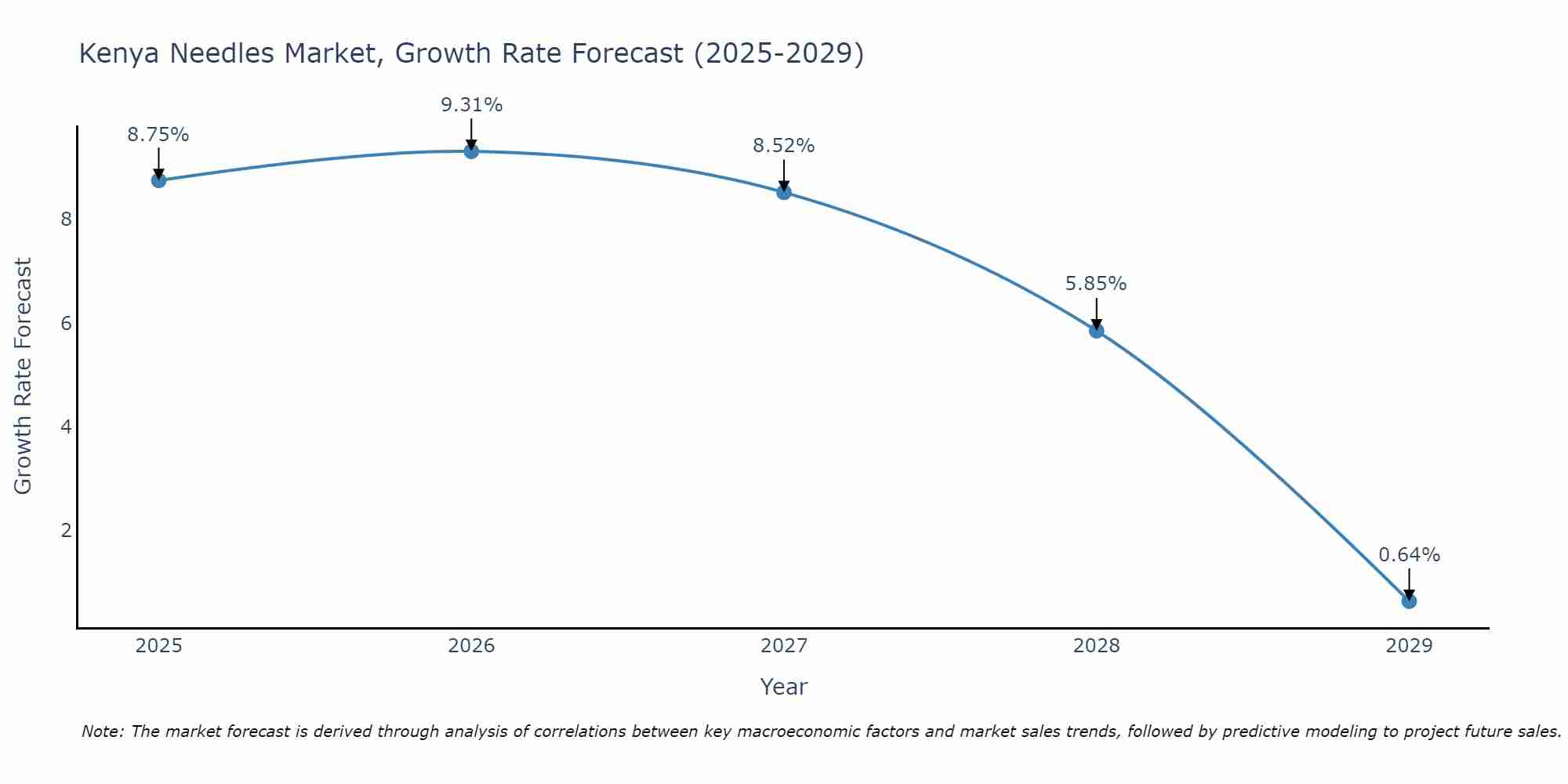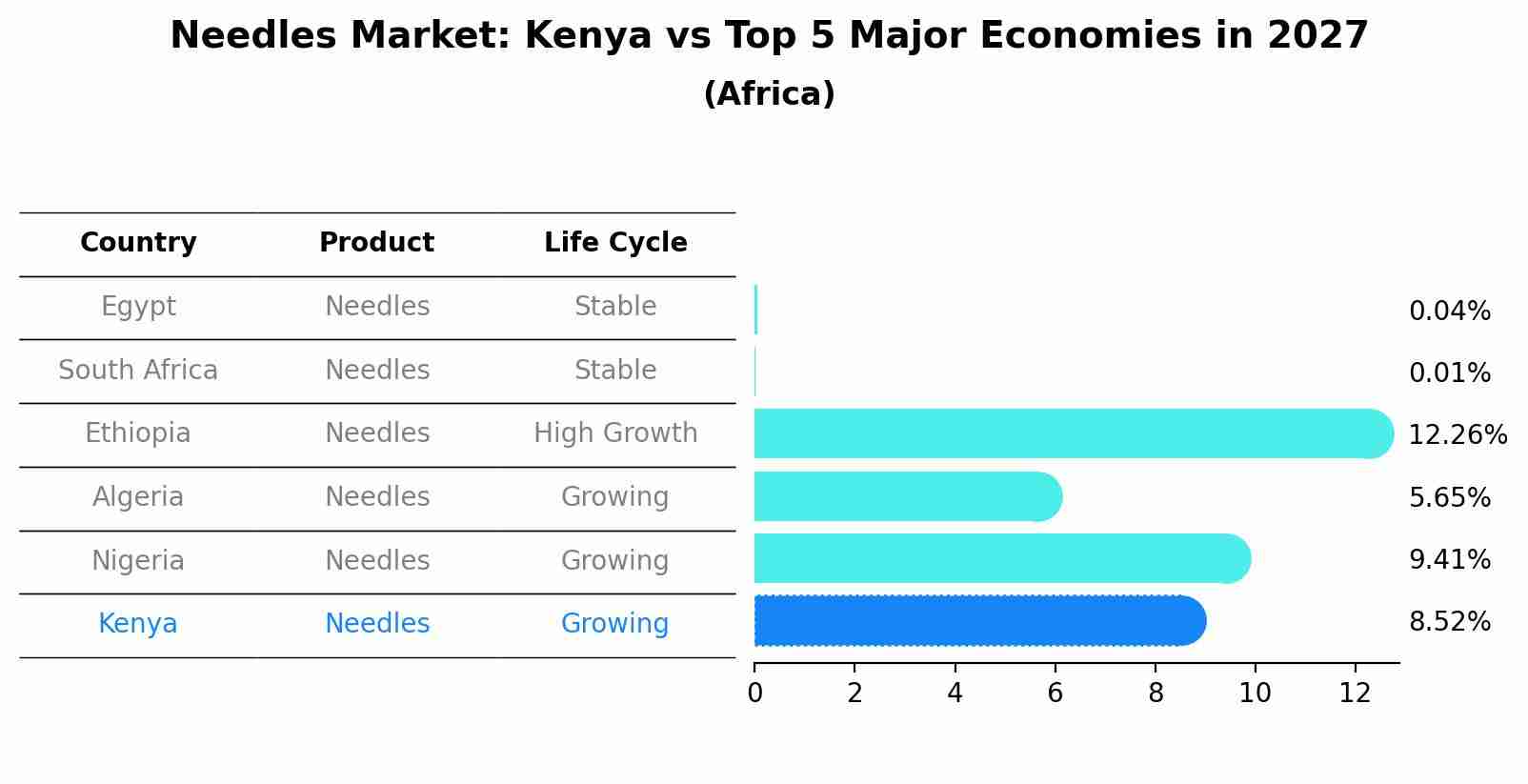Kenya Needles Market Outlook | Analysis, Size, Companies, Forecast, COVID-19 IMPACT, Value, Revenue, Share, Industry, Trends & Growth
| Product Code: ETC376370 | Publication Date: Aug 2022 | Updated Date: Jul 2025 | Product Type: Market Research Report | |
| Publisher: 6Wresearch | Author: Summon Dutta | No. of Pages: 75 | No. of Figures: 35 | No. of Tables: 20 |
Kenya Needles Market Size Growth Rate
The Kenya Needles Market is projected to witness mixed growth rate patterns during 2025 to 2029. Starting at 8.75% in 2025, the market peaks at 9.31% in 2026, and settles at 0.64% by 2029.

Needles Market: Kenya vs Top 5 Major Economies in 2027 (Africa)
By 2027, the Needles market in Kenya is anticipated to reach a growth rate of 8.52%, as part of an increasingly competitive Africa region, where Egypt remains at the forefront, supported by South Africa, Ethiopia, Algeria and Nigeria, driving innovations and market adoption across sectors.

Kenya Needles Market Synopsis
The Kenya Needles Market is witnessing steady growth driven by factors such as the increasing prevalence of chronic diseases, growth in healthcare infrastructure, and rising demand for vaccines and other medical treatments. The market is primarily dominated by the demand for hypodermic needles, followed by specialty needles such as biopsy, spinal, and suture needles. Key players in the market include multinational companies as well as local manufacturers, with a focus on product innovation, quality, and affordability. Government initiatives to improve healthcare access and the expansion of vaccination programs are expected to further boost market growth. However, challenges such as counterfeit products and limited access to healthcare services in rural areas pose barriers to market development. Overall, the Kenya Needles Market presents opportunities for growth and advancement in the healthcare sector.
Kenya Needles Market Trends
The Kenya Needles Market is witnessing several trends, including the increasing demand for safety needles to prevent needlestick injuries and infections among healthcare workers and patients. The market is also experiencing a shift towards the use of advanced technology in needle manufacturing to enhance precision and quality. With the growing prevalence of chronic diseases and the expansion of healthcare facilities in Kenya, there is a rising need for a diverse range of needles, such as insulin needles, biopsy needles, and acupuncture needles. Moreover, the market is seeing a rise in the adoption of eco-friendly and sustainable needles to address environmental concerns. Overall, the Kenya Needles Market is expected to continue evolving to meet the changing demands of the healthcare industry and ensure patient safety and comfort.
Kenya Needles Market Challenges
In the Kenya Needles Market, challenges include fluctuating raw material prices, lack of quality control leading to inconsistent product quality, and competition from cheaper imported needles. Additionally, inadequate infrastructure and distribution networks in certain regions can hinder market penetration and increase costs. Regulatory hurdles and compliance requirements also pose challenges for needle manufacturers, impacting production processes and pricing. Furthermore, limited access to advanced technology and skills training for local needle producers can result in outdated manufacturing practices and hinder innovation. Overall, addressing these challenges through strategic pricing, quality assurance measures, and investments in technology and skills development can help enhance competitiveness and sustainability in the Kenya Needles Market.
Kenya Needles Market Investment Opportunities
The Kenya Needles Market presents promising investment opportunities due to the growing demand for healthcare services in the country. With an increasing population and rising awareness about healthcare, there is a corresponding need for medical needles for various medical procedures. Investors can consider opportunities in manufacturing and distribution of medical needles to cater to the healthcare sector in Kenya. Additionally, there is potential for innovation and technological advancements in needle design to meet the specific needs of healthcare providers and patients. Collaborating with local healthcare facilities, exploring export opportunities, and ensuring compliance with quality standards are key strategies for successful investments in the Kenya Needles Market.
Jordan Agar Market Government Policies
The Kenyan government has implemented various policies related to the needles market to ensure safety and quality standards. The Pharmacy and Poisons Board (PPB) regulates the importation, distribution, and sale of medical devices, including needles, to safeguard public health. The government also encourages local production of medical devices to promote self-sufficiency and boost the healthcare sector. Additionally, the government has introduced initiatives to streamline the approval process for medical devices, including needles, to facilitate timely access to essential healthcare products. These policies aim to enhance the quality, availability, and affordability of needles in the Kenyan market while prioritizing consumer safety and public health.
Kenya Needles Market Future Outlook
The Kenya Needles Market is projected to showcase steady growth in the coming years due to an increasing prevalence of chronic diseases, expanding geriatric population, and rising demand for vaccines and other healthcare services. The market is expected to be driven by advancements in healthcare infrastructure, growing awareness about prevention and control of infectious diseases, and a rise in healthcare expenditure. Additionally, the implementation of government initiatives to improve healthcare accessibility and affordability is likely to further boost market growth. However, challenges such as counterfeit products, inadequate healthcare facilities in rural areas, and limited access to quality healthcare services may hinder the market`s growth to some extent. Overall, the Kenya Needles Market is poised for growth opportunities with a focus on technological advancements and quality healthcare delivery.
Key Highlights of the Report:
- Kenya Needles Market Outlook
- Market Size of Kenya Needles Market, 2021
- Forecast of Kenya Needles Market, 2031
- Historical Data and Forecast of Kenya Needles Revenues & Volume for the Period 2018 - 2031
- Kenya Needles Market Trend Evolution
- Kenya Needles Market Drivers and Challenges
- Kenya Needles Price Trends
- Kenya Needles Porter's Five Forces
- Kenya Needles Industry Life Cycle
- Historical Data and Forecast of Kenya Needles Market Revenues & Volume By Type for the Period 2018 - 2031
- Historical Data and Forecast of Kenya Needles Market Revenues & Volume By Conventional for the Period 2018 - 2031
- Historical Data and Forecast of Kenya Needles Market Revenues & Volume By Safety for the Period 2018 - 2031
- Historical Data and Forecast of Kenya Needles Market Revenues & Volume By Product for the Period 2018 - 2031
- Historical Data and Forecast of Kenya Needles Market Revenues & Volume By Pen for the Period 2018 - 2031
- Historical Data and Forecast of Kenya Needles Market Revenues & Volume By Suture for the Period 2018 - 2031
- Historical Data and Forecast of Kenya Needles Market Revenues & Volume By Blood Collection for the Period 2018 - 2031
- Historical Data and Forecast of Kenya Needles Market Revenues & Volume By Dental for the Period 2018 - 2031
- Historical Data and Forecast of Kenya Needles Market Revenues & Volume By Ophthalmic for the Period 2018 - 2031
- Historical Data and Forecast of Kenya Needles Market Revenues & Volume By Others for the Period 2018 - 2031
- Historical Data and Forecast of Kenya Needles Market Revenues & Volume By Delivery Mode for the Period 2018 - 2031
- Historical Data and Forecast of Kenya Needles Market Revenues & Volume By Hypodermic for the Period 2018 - 2031
- Historical Data and Forecast of Kenya Needles Market Revenues & Volume By Intravenous for the Period 2018 - 2031
- Historical Data and Forecast of Kenya Needles Market Revenues & Volume By Intramuscular for the Period 2018 - 2031
- Historical Data and Forecast of Kenya Needles Market Revenues & Volume By Others for the Period 2018 - 2031
- Historical Data and Forecast of Kenya Needles Market Revenues & Volume By Raw Material for the Period 2018 - 2031
- Historical Data and Forecast of Kenya Needles Market Revenues & Volume By Stainless Steel for the Period 2018 - 2031
- Historical Data and Forecast of Kenya Needles Market Revenues & Volume By Glass for the Period 2018 - 2031
- Historical Data and Forecast of Kenya Needles Market Revenues & Volume By Others for the Period 2018 - 2031
- Kenya Needles Import Export Trade Statistics
- Market Opportunity Assessment By Type
- Market Opportunity Assessment By Product
- Market Opportunity Assessment By Delivery Mode
- Market Opportunity Assessment By Raw Material
- Kenya Needles Top Companies Market Share
- Kenya Needles Competitive Benchmarking By Technical and Operational Parameters
- Kenya Needles Company Profiles
- Kenya Needles Key Strategic Recommendations
Frequently Asked Questions About the Market Study (FAQs):
- Single User License$ 1,995
- Department License$ 2,400
- Site License$ 3,120
- Global License$ 3,795
Search
Related Reports
- ASEAN and Thailand Brain Health Supplements Market (2025-2031) | Strategy, Consumer Insights, Analysis, Investment Trends, Opportunities, Growth, Size, Share, Industry, Revenue, Segments, Value, Segmentation, Supply, Forecast, Restraints, Outlook, Competition, Drivers, Trends, Demand, Pricing Analysis, Competitive, Strategic Insights, Companies, Challenges
- ASEAN Bearings Market (2025-2031) | Strategy, Consumer Insights, Analysis, Investment Trends, Opportunities, Growth, Size, Share, Industry, Revenue, Segments, Value, Segmentation, Supply, Forecast, Restraints, Outlook, Competition, Drivers, Trends, Demand, Pricing Analysis, Competitive, Strategic Insights, Companies, Challenges
- Europe Flooring Market (2025-2031) | Outlook, Share, Industry, Trends, Forecast, Companies, Revenue, Size, Analysis, Growth & Value
- Saudi Arabia Manlift Market (2025-2031) | Outlook, Size, Growth, Trends, Companies, Industry, Revenue, Value, Share, Forecast & Analysis
- Uganda Excavator, Crane, and Wheel Loaders Market (2025-2031) | Strategy, Consumer Insights, Analysis, Investment Trends, Opportunities, Growth, Size, Share, Industry, Revenue, Segments, Value, Segmentation, Supply, Forecast, Restraints, Outlook, Competition, Drivers, Trends, Demand, Pricing Analysis, Competitive, Strategic Insights, Companies, Challenges
- Rwanda Excavator, Crane, and Wheel Loaders Market (2025-2031) | Strategy, Consumer Insights, Analysis, Investment Trends, Opportunities, Growth, Size, Share, Industry, Revenue, Segments, Value, Segmentation, Supply, Forecast, Restraints, Outlook, Competition, Drivers, Trends, Demand, Pricing Analysis, Competitive, Strategic Insights, Companies, Challenges
- Kenya Excavator, Crane, and Wheel Loaders Market (2025-2031) | Strategy, Consumer Insights, Analysis, Investment Trends, Opportunities, Growth, Size, Share, Industry, Revenue, Segments, Value, Segmentation, Supply, Forecast, Restraints, Outlook, Competition, Drivers, Trends, Demand, Pricing Analysis, Competitive, Strategic Insights, Companies, Challenges
- Angola Excavator, Crane, and Wheel Loaders Market (2025-2031) | Strategy, Consumer Insights, Analysis, Investment Trends, Opportunities, Growth, Size, Share, Industry, Revenue, Segments, Value, Segmentation, Supply, Forecast, Restraints, Outlook, Competition, Drivers, Trends, Demand, Pricing Analysis, Competitive, Strategic Insights, Companies, Challenges
- Israel Intelligent Transport System Market (2025-2031) | Strategy, Consumer Insights, Analysis, Investment Trends, Opportunities, Growth, Size, Share, Industry, Revenue, Segments, Value, Segmentation, Supply, Forecast, Restraints, Outlook, Competition, Drivers, Trends, Demand, Pricing Analysis, Competitive, Strategic Insights, Companies, Challenges
- Uganda Precast and Aggregate Market (2025-2031) | Strategy, Consumer Insights, Analysis, Investment Trends, Opportunities, Growth, Size, Share, Industry, Revenue, Segments, Value, Segmentation, Supply, Forecast, Restraints, Outlook, Competition, Drivers, Trends, Demand, Pricing Analysis, Competitive, Strategic Insights, Companies, Challenges
Industry Events and Analyst Meet
Our Clients
Whitepaper
- Middle East & Africa Commercial Security Market Click here to view more.
- Middle East & Africa Fire Safety Systems & Equipment Market Click here to view more.
- GCC Drone Market Click here to view more.
- Middle East Lighting Fixture Market Click here to view more.
- GCC Physical & Perimeter Security Market Click here to view more.
6WResearch In News
- Doha a strategic location for EV manufacturing hub: IPA Qatar
- Demand for luxury TVs surging in the GCC, says Samsung
- Empowering Growth: The Thriving Journey of Bangladesh’s Cable Industry
- Demand for luxury TVs surging in the GCC, says Samsung
- Video call with a traditional healer? Once unthinkable, it’s now common in South Africa
- Intelligent Buildings To Smooth GCC’s Path To Net Zero













